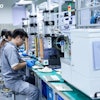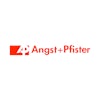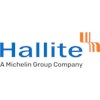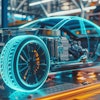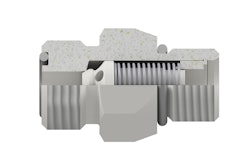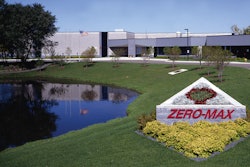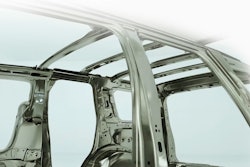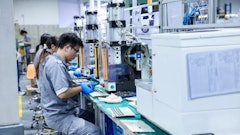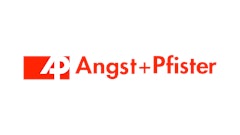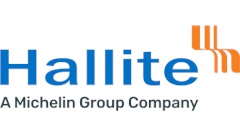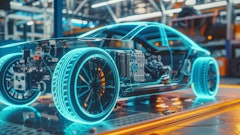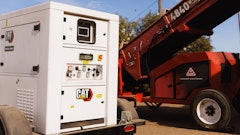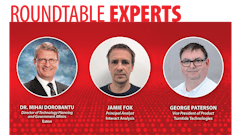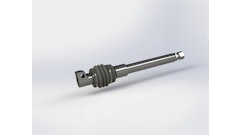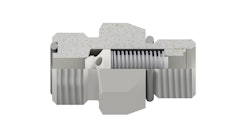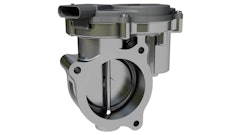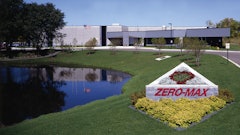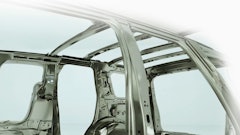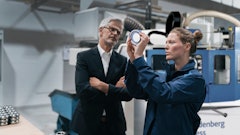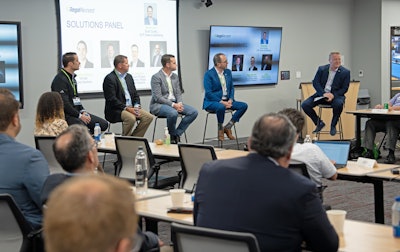
The Regal Rexnord organization is comprised of Regal Beloit, Rexnord and Altra Industrial Motion, each heading various segments of the industrial industry through industrial powertrain solutions, automation and motion control, and power efficiency solutions.
While at a media day in Milwaukee, Wisc., CEO Lewis Pinkham expressed his gratitude to his team for their work and efforts in helping them grow to the corporation they are today. “We couldn’t have done it without the team, and I do believe we’ve been on quite a transformation. I’m so proud of this company and that we’re building in the portfolio that we have today,” he says.
Ultimately, the greatest value of Regal Rexnord is their dedication to having a “solutions mindset.” Through that come changes to their products as industries adapt to their markets. A panel of representatives shared their insight.
Question: From a digital perspective, how does Regal Rexnord support the customer's goals of reducing downtime?
Robert Federer, Vice President – General Manager Digital Solutions: I think it's more than just digital, right? We think about the entire value proposition as the company. What's the purpose of the plan? It's production output, right? That downtime costs money. That's a different dollar figure with different industries, which helps drive our focus.
But I think that's what the company's been successful for its 125+ years because equipment effectiveness in the uptime of your equipment is paramount. I think now you're seeing the new Regal Rexnord.
What Jason, with the powertrain team, is working on is we have now the ability to bring mechanical powertrain solutions together that is unmatched with our competition. That takes that optimization of the equipment, the efficiency, and the uptime to the next level. Then you throw different services that the company has on top of it. We've got more than just digital services. It starts with repair services that will go into facilities and help repair equipment. That's helping get customers up and reduce downtime. We have other teams that go in and do asset audits that help customers know where equipment is, and then the reliability engineering services, where we go in solution around a technology that can monitor health of equipment, remotely, monitor those things that gets ahead of downtime by predicting that failure.
We did a large, almost 2,000-person maintenance and reliability professional survey about a year ago, the #1 thing that was requested by that end user population on a predictive maintenance dashboard was having a product interchange. Why is that? They want speed and find and replacement to reduce that downtime. That's the value proposition we have today.
It's about supply chain resiliency. There’s safety aspects to that. There's sustainability aspects to that. But when you look at the whole value proposition of the company and the amplifier that digital technology is on top of that. I think we've got a pretty unique value proposition.
Question: Regal Rexnord serves many different diverse industries, but the one thing that's true to all of them is the workforce is changing rapidly. How do Regal Rexnord solutions aid in addressing skill and labor shortage?
Federer: Labor efficiency is a big metric for our end user customers. The team spoke about our 80/20 culture and how we drive focus. You've got skill gaps, or you've got labor shortages. In the plants, how can we help? Those end users drive focus that optimizes that labor efficiency.
Our services fill that gap in a lot of different ways. The other side of our business is selling to original equipment manufacturers, and their labor efficiency is just as important everything before the products bought. You heard the team earlier. A lot of interaction happens before a customer ever talks to us.
So, how are we optimizing that digital customer experience to save them time for them to do their job around finding a product, configuring the product, buying the product, in a self-serve manner that they could do at night, they can do early morning? They're not waiting on somebody else. That's a big part of the digital customer experience that we think we're an industry leader on and are continually to invest in and to optimize labor efficiency across — not just those end user facilities, but our OEM customers also.
Jason Quackenbush, VP and GM of Industrial Powertrain Solutions: Building on that, when I think about the attrition that we're seeing in the marketplace — it's not only from the plant level, it's also from the design or the skill set that some of these organizations have. Some of them outsource it today. They contract engineering firms to do the design work, whereas what we're building with the powertrain team is to build that in-house. We have the industry knowledge from our asset of engineers that work in these industries — we're building that solution together today.
We're really augmenting the skill sets. We're seeing that startup companies are really engaged in the technology they're offering, not so much in how they're creating it, or how they're producing their products. That's where we come in and can help them with the system and the solution itself. You focus on your technology. We’ll enable the power transmitted piece of their manufacturing process that will support them.
Question: Regal Rexnord has so many solutions helping end users reach their sustainability goals. Diego, would you like to sort of discuss that in terms of what we're doing on the HVAC side relating to sort of sustainability in the customer needs?
Diego Marafon, Senior Director Product Management, Power Efficiency Solutions: Absolutely. Just stepping back a little bit, we upgraded or elevated our business purpose and added at the center of its sustainable solutions. And for many, many years, it has guided everything we do, not differently in the HVAC space. I'll mention three, but there are many other fronts where we are rolling out sustainable solutions. One is really the electrification via decarbonization — heat pumps is a big one out there.
We are launching technologies to enable the roll out of heat pumps, and then really the decouple. I could go on and keep mentioning a couple other applications related to heat pumps, but then heat pumps are not going to take over tomorrow. There is a transition phase here that the industry is going through. There's still a lot of gas out there. We keep upgrading our products so that they are more efficient and help customers transition throughout this the next few years, until eventually we become a fully electrified society. That's the first one.
The second one that I will touch on, is energy efficiency. Regal Rexnord is well known for its leadership with the EC motors, and we continue to invest in that direction. Every new motor solution that we're developing is based off a motor platform that is ACM, and therefore more efficient. Products are being rolled out into the market.
The estimates will say that more than a third of the energy consumed is from HVAC and our systems. This is how impactful a more efficient solution can be in the overarching energy consumption space. And then you have some specific industries like the data center space, but specifically in cooling the servers and the higher density equipment that are more and more being demanded. We have products specifically to support more sustainable solutions.
Third is more sustainable refrigerants. In HVAC, our industry often calls these as the low-GWP (low global warming potential) refrigerants. Many of those refrigerants that are available out there are classified as mildly flammable when compared to the traditional ones, and therefore require safer, fully sealed or different configured type of products. We've been supporting all of those components and technologies that then get integrated into a HVAC.
Question: It would be great if you each could share sort of a notable recent development that speaks to you. How is Regal Rexnord innovating with purpose to help our customer goals?
Quackenbush: Truthfully, the ones that are most impactful for me, personally and professionally, is the safety component. As we looked at some of the different product innovations throughout the segments - it may not be very apparent that it's safety, but think about some of the bearing and gearbox washed out capabilities providing longer life, less breakage. What happens when you shut the machine down and you have people interacting with it? There's a risk. There's a risk of being injured. There's a risk of replacing a component.
I remember long ago, in my early career, when I was at a mine site. His maintenance plan was that every time I have to replace something, I increase my risk. The less I have to repair something to replace them, we're a safer environment. To me, the big innovation with purpose is not the cool new features, not all the other things that are involved in it, but increasing that safety element by longer like less repair work and less service required. That's really what that's what is impactful.
Marafon: I'll add two. One, data centers and the second one is clean rooms in the semiconductor space — two of the fastest growing spaces in America right now.
Basically, we developed a product that is built on one of our EC motor platforms. Everything we do is based on ECM - the way we packed it all together with a smart controller makes it one of the most efficient products in the market but in a very, very complex size. When you bring it into a data center, it's like the power density is getting bigger and bigger. Cooling needs are going up, and you need it to be done in as much of a minimum space possible as possible.
The second is the is the fan filter unit that we fully assemble and ship directly to jobsites. Picture us building directly with the contractor or whoever's building a multi-billion-dollar chips fab site and putting 1,000s of those units in a specific area.
Not only are we solving the problems but we're helping to solve the supply resilience as a whole.
Federer: Three things that come to mind. Every great story needs a villain. I think our villain in my story here is customer complexity. We talked about being one Regal Rexnord…because part of being with Regal Rexnord is we get to operate not as a company, but as an organization. There’s a lot of integration work to do, and we're doing that behind the scenes to eliminate that complexity that the customers have and trying to do business with Regal Rexnord as an organization.
Number one is our new perceptive, intelligent reliability platform that is trying to take three legacy company’s IoT solutions and integrate into a single platform so a customer has one way to manage asset health monitoring and powertrain asset management versus 11 ways.
The second is we inherited multiple web and eCommerce sites where a lot of transaction is happening with OEM, procurement buyers, distributor buyers, to our companies. But how are we trying to get to Regal Rexnord as an organization? We are migrating all that from one website to Regal Rexnord to be that single e-commerce space to cross sell that entire power train portfolio.
The third is probably the biggest, that is how do we get internally, one way to manage all of our orders when a customer wants to place a single purchase order with this organization?
Data is a big conversation these days. Typically, people are talking about it from an AI standpoint or a machine learning (ML) standpoint. We are building an order management platform that allows our customers to buy on a single purchase order. Even though we know we have a lot of complex systems, different systems and different manufacturing sites that make those products, we're trying to eliminate all that complexity so that the customer has a seamless, easy way to do business with us. Those are massive projects.
Question: Regal Rexnord helped a warehouse distribution center and showed documented savings of $90,000 a year. Can you expand on what the customer needs were, what challenges and pain points were addressed, and what solution Regal Rexnord provided?
TJ Landrum, General Manager - Automation Solutions Business Unit - Food, Beverage & Packaging: This is a great example of innovation with purpose and solving problems. As a systems business, we are focused on understanding the customer needs and how you solve a problem in a unique way.
I think there's been a lot of changes in in how people get product over the last several years. There’s a lot more e-commerce, but everything's not coming on pallets and in big boxes. There's a lot of variation in that process. If you think about legacy conveyor systems within a warehouse distribution type of environment, they're set up for boxes and flat bottoms. If you throw a bag in there, it's probably not going to make it around the turn. It's probably going to get stuck somewhere.
When you when you look at that kind of application, this particular customer was sorting manually envelopes and polybags and putting them in totes. The totes would run through and be diverted and moved across the warehouse. With the capabilities we have — our ModSort product is designed with that kind of situation in mind, it's a closed top belts with directional rollers and can move polybags as well as can move boxes. We were able to come into that situation and look at what the customer had, how much money they were spending in sorting, manually putting into totes, the heaviness of the totes, and offer a solution with ModSort as the sorting and divert module so they could run those polybags through and take out a whole lot of labor.
It's a great win when you can solve that problem, see that from a system perspective, and be able to utilize and leverage all the expertise within Regal Rexnord as far as belting and high-efficiency motors — pulling them together into something that is tangible and results for a customer.
Question: Regal Rexnord has a lot of factories that deploy a lot of technology. What insights have you gotten from your own factory that support development or the way of moving forward? What insights surprised you?
Landrum: As the systems equipment manufacturer for automation solutions, we're usually the first to use them. Great example, there's a newer zero tangent curve that really has a tight radius within the conveying systems. We were the first OEM to utilize that. We're able to get that in the field and get a lot of learnings right off the bat and then be able to feed that right back into the product line team so that they could make adjustments to that product and understand real world application before it gets too far out. We try to do that as much as we can.
Federer: We've got the new platform that we just released implemented in two of our facilities. One in Cudahy (Greater Milwaukee) and at our Florence, Ken. facility. There's kind of two things that come to mind. One, folks that we're doing route-based — going and checking on things as preventive maintenance. I think there's the light switch that's going on, “I can rely on another tool that saves me time.” I think that value proposition is being confirmed.
The second, depending on the personnel and the facilities you're going to get different insights or different rate of adoption. We have facilities where we have Regal Rexnord business system process people that are driving continuous improvement or strong digital transformation and system thinkers inside that facility that are driving people in process to adopt new ways of working. There are others that are still on that journey. We just launched it in June [2024], and we're starting to roll out.
The second floor has our Innovation Center for our intelligence solutions, I'd encourage anyone that hasn't been up there to go take a look, because we do have similar to what TJ was saying, the ability to run simulations there on a full powertrain set of Regal Rexnord equipment. The goal is we want to predict failure, but ultimately we want to optimize our core product designs at scale. How do we start to build in the capabilities in that lab so that our different engineering teams can collaborate in that space? We are optimizing bearing design. We are optimizing gearbox design or motor design that's delivering sustainability value propositions to customers at large. I think there's a multitude of benefits that we're seeing given the different teams and where they're at from a people and change.
Question: As the older generation ages out and the younger generation does things in a totally different way, how much consideration or what kind of consideration does Regal Rexnord consider when designing equipment and technology to make it accessible for the younger generation?
Federer: We are a data-driven decision-making tech company. I always gravitate to “where's the data that I can look at” and “how do we segment that.” We look across dozens of websites that we have inside the portfolio, and we go straight to the analytics of who's on each site. And if you are doing in person, voice of customer interviews, they're going to tell you something, but their behaviors may be totally different.
We're very targeted around knowing what's the demographic of who gave us that feedback, and how do we drop that into our software development team's hands to say, “let's go solve that problem or make that more efficient.” Because there's a change in the behavior. Maybe that's a change in the persona, or an early-, mid- or late-career persona that's changing throughout the customer journey. Those are all muscles that that we have built over the last couple years in forming a pretty permittable digital solutions team, taking a lot of talent from the legacy three companies.
Every company was really strong in particular areas so we have been able to build a really strong team that's outside-in, informed, and prioritized based on customers. We don't innovate unless we're solving for something that we're aware of it. And that takes a pretty strong prowess from a web analytics, digital analytics, and trying to look at that across their customer journey and saying, “are you trying to configure something? Are you trying to select something? And those are multiple clicks?” There's a lot of data intelligence that goes into forming what we do and who we're doing it for.
Quackenbush: I think if we go back to some specific products, I think of the Rex Pro Chain. I think about how we used to have to service it and how we used to have to replace it. It would use a special tool, someone probably with special knowledge on how to use the tool. Someone who has expertise on just getting the fit just right, so that you had that correct fit, so you didn't have premature failure. Now, in our design — our innovation with purpose — we said, “First of all, was that the same safer way to do it.” That was at one of the forefronts, but it was also the ease and knowing that maintenance and end users and the skill set is definitely changing over time.
We designed it so that it's a simple installation with an impact wrench. No special tooling. No special fits. That allows for much easier installation. I think in general, when we're developing our new products, we think about that. We think about the serviceability a lot more than we ever have previously. Because before, we were really worried about creating the best product, now we're worried about creating the best product with the ease of using the product, because we know that that expertise is going away. That's really what's going to help us differentiate ourselves.
Then, as a solution piece, just knowing how all our products interact allow us to really develop something that is unique. I think of an example of where we were given an application where we had 12 components to supply. We reduced it to two because it wasn't the smartest solution. I think taking that complexity out of systems or solutions, design also drives a big part of it because now you don't need to maintain a belt, now you don't need to maintain “this,” “that,” or maintain it over time. I think that's innovation. It's different type of innovation in that regard.
Marafon: In the HVAC/R industry, one electronically commutated motor (ECM) can replace multiple conduction motors. We’ve been big into designing some of the newer ECMs. The Evergreen is an example that contractors can carry in their truck — carry one motor to replace more than 10 traditional induction motors. Making it simpler for the ones that are out there actually doing the repairs, doing the replacements.
I think traditionally, we were mostly engaged with all the OEMs. OEMs was the primary channel to talk to end users. Now we've been more and more and more engaged with contractors so that we can support them with this solution and others. But then also training and speaking directly to them on how to deploy the products and software.
Landrum: On the systems and equipment side, 10 to 20 years ago, they knew exactly what they wanted, and it was really easy to design, drop it in, everything was pretty darn perfect. Now, it changes 10 times.
Fundamentally, we have to kind of change our business process a bit, leveraging our field service team, and we're really building that out. We're actually piloting and vetting field service people into larger strategic customers, so that we have that connection and that intimacy. When the opportunity and the need comes along for a system overhaul or a new piece of equipment, they have some knowledge so that we can help them out. I think there's some opportunity for us to really differentiate ourselves and leverage the knowledge of the organizational role.
